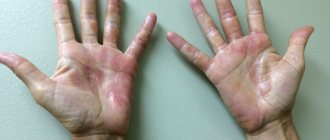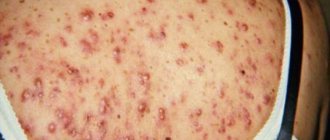One of the most common pathologies is skin fibroma (fibropapilloma), which is a benign tumor consisting of connective and adipose tissue. This pathology is not prone to grow into nearby structures and very rarely can transform into cancer, but still requires qualified treatment. People very often encounter the appearance of various skin tumors that cause them discomfort, especially when they form on open areas of the body.
In the presence of fibropapilloma, clinical manifestations completely depend on the location of its appearance. Most often, fibroids can cause pain, general malaise and deformation of the affected area. In order to promptly identify pathology, you should study its causes and symptoms in advance. Diagnosis of such formations is carried out in dermatology. Treatment is usually carried out through surgery, but other methods of therapy can be used, which are determined based on the size and location of the fibroid.
What is fibroma
Fibropapilloma is a benign tumor consisting of adipose and connective tissue. Such neoplasms are far from uncommon among the population, but not many people know what they are.
Pathology can be of different localization, but usually fibroids affect those parts of the body where the skin is regularly rubbed:
- upper chest;
- armpits;
- neck;
- groin area.
Fibropapilloma may also appear on internal organs, for example, on blood vessels or in glandular tissues. The development of such tumors usually occurs slowly, and the size rarely reaches more than three centimeters. Fibromas can be either single or multiple, and such tumors rarely develop into cancer. Based on its location, if the tumor is large, it can also put pressure on nearby structures and organs, thereby causing their dysfunction. Therefore, treatment of such formations should be carried out in a timely manner. After removal, relapses of pathology are practically not observed.
Definition
Fibroma is a benign growth that can be localized in any part of the body. The tumor consists of fibrous tissue that develops through uncontrolled cell division.
Fibroids can develop both on the surface of the skin and in the deep layers of muscle tissue . Basically, this disease affects adults and only in isolated cases is it diagnosed in children.
Causes
Scientists have not yet studied the reasons for the appearance of subcutaneous fibroma, but the most likely factor provoking the development of pathology is considered to be genetic abnormalities that are inherited. In young children, fibropapillomas are usually not detected; their occurrence occurs after puberty.
Other factors can also provoke the growth of skin formations:
- natural skin aging;
- increased sweating;
- hormonal imbalances;
- presence of diabetes mellitus and tuberculosis;
- excessive consumption of junk food.
Other causes of skin fibropapilloma are often external factors:
- frequent rubbing of the skin with clothing;
- insect bites;
- skin injuries (abrasions, cuts);
- inflammatory processes on the skin.
The risk of this tumor increases if you take hormonal medications and during the period of hormonal changes in the body.
Preventive measures
To date, there are no specific measures to prevent fibroids.
Each person should be attentive to their health, promptly adjust the hormonal balance, systematically cleanse the body of parasites, and prevent the negative influence of external factors on the skin. In addition, it is necessary to balance the diet, lead a healthy lifestyle, and maintain a high level of immunity.
If any neoplasms appear on the skin, it is recommended to visit a specialist and conduct all diagnostic tests to exclude serious diseases.
Classification and localization of fibromas
Fibroids are detected in almost any area on the human body, but the exact location of the formation largely depends on the type of pathology.
We recommend reading Tumors of the sigmoid colon, their symptoms, causes and treatment
The following types of tumors are distinguished:
- Soft fibroma - the formation is extremely rare, and usually forms in places where there is frequent friction between the skin and tissue (neck area, under the knee, groin, armpits). Externally, the tumor is a pouch with wrinkles, consisting of adipose tissue.
- Hard fibroma (dermatofibroma) is a fairly common pathology, which is most often observed in the face, back and shoulders, but can also form on the mucous membranes. Externally, this dense, painless formation has the appearance of a pea, and it forms both on the skin and under it. Fibroids under the skin are characterized by slow development and are equally found in both the female and male half of the population. Sometimes this form of tumor has a stalk and looks like a simple wart.
- Desmoid fibroma - the structure of the formation is similar to a solid tumor, and most often this type of fibroma is formed on the anterior wall of the peritoneum. The main differences between desmoid neoplasms are rapid and aggressive growth, as well as a high risk of malignancy.
When a person experiences rapid growth of formations, this may indicate the presence of a disease such as fibromatosis. Such neoplasms usually appear on the feet, and not only the skin, but also muscle tissue is affected. The cause of the development of this pathology can be injuries to the legs or the presence of tendon tumors. The development of fibromatosis may be accompanied by painful sensations, and special ointments must be used for treatment.
Diagnostic methods
Numerous photos of fibroids on the leg under the skin give only a superficial idea of the tumor. Without a professional approach, based on them, it is impossible to accurately determine either the nature of education or its type. Only complete histological studies allow us to assert that the tumor does not threaten a malignant form. Thus, fibroma is diagnosed using a biopsy (cutting off part of the affected tissue and studying it in the laboratory).
Symptoms
Fibropapillomas are very easily confused with many other skin formations, for example, wen, moles or papillomas.
To accurately identify fibroma developing on the skin, you should familiarize yourself with the main symptoms of this pathology:
- the presence of clear boundaries;
- size in diameter no more than 3 cm;
- mobility of education;
- the color matches the skin, or with long development it becomes purple-bluish;
- slow growth;
- intense bleeding in case of injury.
In addition to the above general characteristics, each individual species is characterized by other individual manifestations.
Signs of soft skin fibroids are:
- loose and soft structure;
- the surface of the neoplasm has irregularities and dents;
- pain, usually caused by friction;
- mobility of education;
- Tumors can be multiple, with the number sometimes reaching several dozen.
In the case of dermatofibroma, the symptoms are slightly different:
- the structure of the formation is dense;
- the surface of the tumor is smooth;
- the formation on the skin is not mobile;
- Single fibromas are usually found.
When fibropapilloma occurs, the color of fibropapilloma is the same as that of healthy skin, but as the pathology develops, it becomes darker. This neoplasm does not cause any harm to health, but in open areas of the body it is a cosmetic defect, and in case of mechanical damage it can bleed heavily.
Consequences of skin pathology
Fibroma that affects the skin tissue is considered harmless. The cosmetic appearance of the tumor causes discomfort.
Fibroma can become dangerous if the nevus is damaged:
- Tumor bleeding;
- A foreign infection penetrates through an open wound, which can cause re-infection;
- Pain at the site of the fibroid;
- Healthy dermis and tumor lead to necrosis.
Fibropapilloma transforms into malignant cancer very rarely. This occurs when the nodule rapidly increases to the size of the palm of your hand. Soft fibromas are susceptible to transformation. At the same time, there are sometimes a large number of neoplasms on the body. A hormonal disorder can provoke a mutation.
Diagnostics
If pathological formations appear on the skin, the first thing you need to do is contact a dermatologist and undergo a full examination. The doctor will conduct an external examination and palpation of the tumor.
Sometimes fibropapillomas are confused with other formations that occur on the skin, so it is important to differentiate fibroma from pathologies such as fibroadenoma, malignant melanoma of the skin and skin carcinoma.
To make an accurate diagnosis, the patient is prescribed the following studies:
- biopsy;
- cytological examination;
- histological analysis;
- fluoroscopy or ultrasound examination (ultrasound).
We recommend reading: Symptoms and treatment of prostate adenocarcinoma
The above diagnostic methods allow you to accurately determine the type of formation, as well as identify the symptoms of cancer in the case of tumor malignancy. If fibroids are detected in women on internal organs, patients need to undergo additional examination by a gynecologist and mammologist.
Diagnosis of the disease
Skin neoplasms are identified by visual inspection. But to clarify the diagnosis, histology of the biological material is required. The sample is taken after surgical removal of the nevus. This allows us to exclude the possibility of lipoma, hygroma with atheroma. The skin formation is a nevoid node of connective tissue with a fiber structure. The tissue is filled with blood vessels, in which swelling and inflammation are possible.
Pathology of the oral cavity is often detected by a dentist during examination or treatment of a patient. If a suspicious lesion is detected, an extensive examination is required to clarify the diagnosis:
- An ultrasound examination of the mouth will reveal the depth of tissue damage.
- X-ray with radiovisiography will help to identify inflammatory processes inside the formation when using an orthopantomogram with a periodontogram.
- If the patient has dentures, consultation with an orthopedic dentist is recommended.
- After the tumor is removed, the biological sample is sent to the laboratory for biopsy and histology.
The formation of fibroids in the tongue requires excluding the possibility of tongue cancer. To do this, appropriate diagnosis is carried out, excluding other neoplasms.
Fibroma treatment
When choosing a treatment method, doctors take into account the size of the fibroid and its location. In certain cases, fibroids should be treated with conservative methods, for example, small soft fibroids are eliminated through special injections. Surgical removal of fibroids is usually resorted to when they grow to an impressive size.
In addition to standard surgery, there are other methods for removing this pathology:
- laser removal is a very effective method for eliminating tumors on exposed parts of the body, especially on the face or neck;
- removal by radio waves - the tumor is excised using a radio knife, and the procedure requires only about 15 minutes;
- cryodestruction - small formations are removed by using liquid nitrogen or dry ice;
- electrocoagulation - the tumor is eliminated using current discharges;
- chemical method - cauterization of tumor tissue with aggressive chemicals.
Also, to treat fibropapillomas that appear on the skin, people often use traditional methods of treatment. But before starting self-therapy, in order to avoid any complications, you should definitely discuss this with a specialist.
Surgical removal
When a patient is diagnosed with a large tumor that develops deep in the skin, surgery is used to remove it. Surgical removal of fibroids is carried out using local anesthesia for twenty minutes. The disadvantage of surgery to remove such formations is the presence of scars, which may remain even if cosmetic stitches are used. During the operation, it is necessary to completely remove all parts of the tumor, otherwise the pathology may recur.
Laser removal
Elimination of tumors on the skin using a laser allows you to avoid cosmetic defects, which is especially important in the presence of formations on the face, neck and other open parts of the body. This procedure is carried out within 15-20 minutes. During the procedure, the laser removes only the tumor, while immediately cauterizing the blood vessels, which helps prevent bleeding. After laser removal of skin tumors, relapses almost never occur.
Treatment without surgery
In some cases, treatment of fibropapillomas can be carried out using conservative methods, for example, if the skin tumor is small, it is treated with steroid injections. The drug "Diprospan" is often used. The injection is given directly into the tumor. Such remedies can significantly reduce the size of the tumor and even eliminate it completely. However, in a large number of cases, surgical intervention is necessary.
We recommend reading Submucous uterine fibroids - causes, treatment, symptoms
Folk remedies
Very often, instead of going to the hospital, people resort to traditional methods of treatment. They can be a variety of ointments that can be prepared at home, as well as herbal decoctions and lotions.
The most common methods of folk treatment for fibroids arising on the skin are:
- lotions from celandine juice;
- using potato juice to treat tumors;
- treating fibroids with camphor alcohol no more than three times a day;
- decoction of oak bark or calendula;
- iodine lotions with alcohol tincture of aloe.
Traditional medicine can be a good addition to the main treatment, but before using traditional methods, you should definitely consult a doctor to prevent possible complications and consequences.
The danger of fibroma and its complications
Fibroids are considered safe formations of a benign nature. They almost never transform into cancer, but still the risk of malignancy remains. Therefore, the treatment of fibroids must be taken seriously. The localization of formations is of great importance. If a fibroma appears on the skin or in the area of the lungs and pleura, it does not transform into cancer. But a tumor that has formed on the mucous membrane, for example, in the mouth or in the uterine area, is prone to malignancy. If the fibroma grows to an impressive size, it can put pressure on nearby structures, thereby disrupting their functioning, and also cause intense clinical manifestations. In addition, fibromas localized on the skin, especially in open areas, are often subject to injury. In this case, heavy bleeding is possible and there is a high likelihood of infection.
Prognosis and prevention
Fibroma is not a dangerous neoplasm, therefore, subject to timely and adequate treatment, the prognosis is favorable. In this case, the formations are eliminated before any complications develop, thereby preventing the likelihood of malignancy. The pathology does not cause harm to health, and if laser or radio wave treatment is used during therapy, the risk of relapse is almost completely eliminated.
There are no specific ways to prevent the appearance of fibroids in different areas of the skin. You can reduce the risk of developing such a pathology if you follow some rules:
- lead a healthy lifestyle;
- monitor skin condition;
- adhere to a healthy diet;
- timely treatment of chronic skin diseases;
- undergo regular medical examination.
To keep your skin healthy, you should include dairy products, as well as fruits and vegetables, in your daily diet. Apples, viburnum, cucumbers and tomatoes are especially beneficial for the skin.











